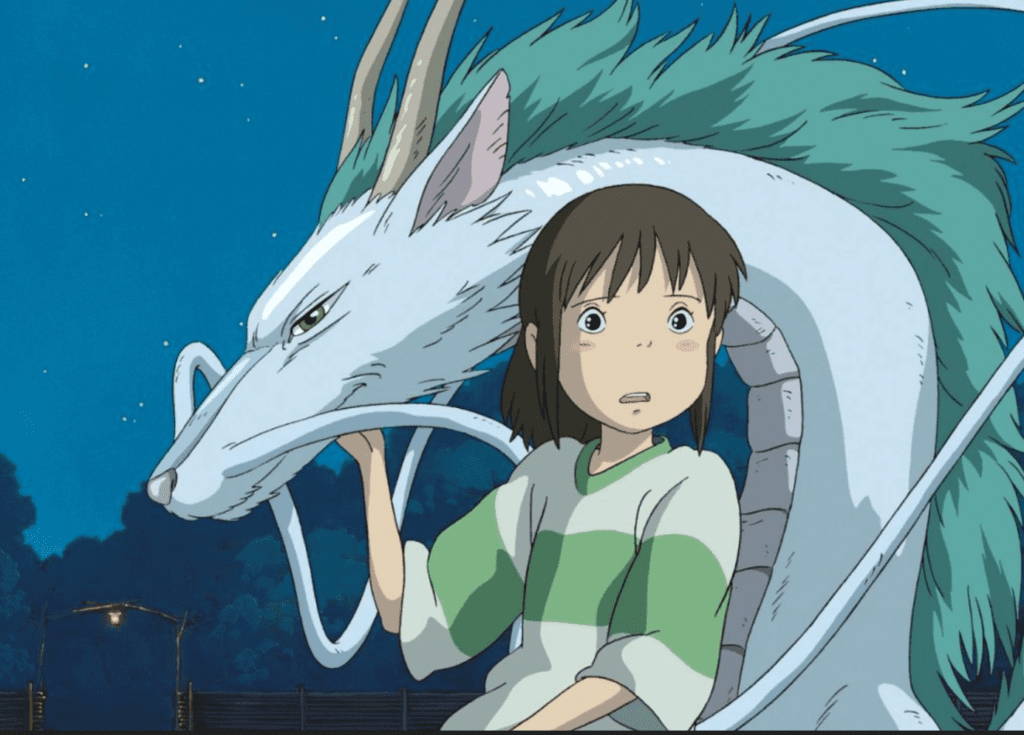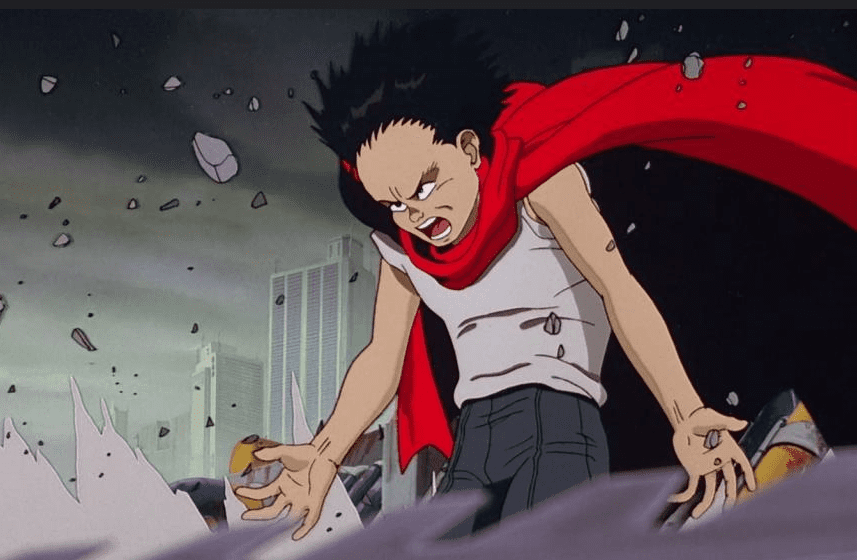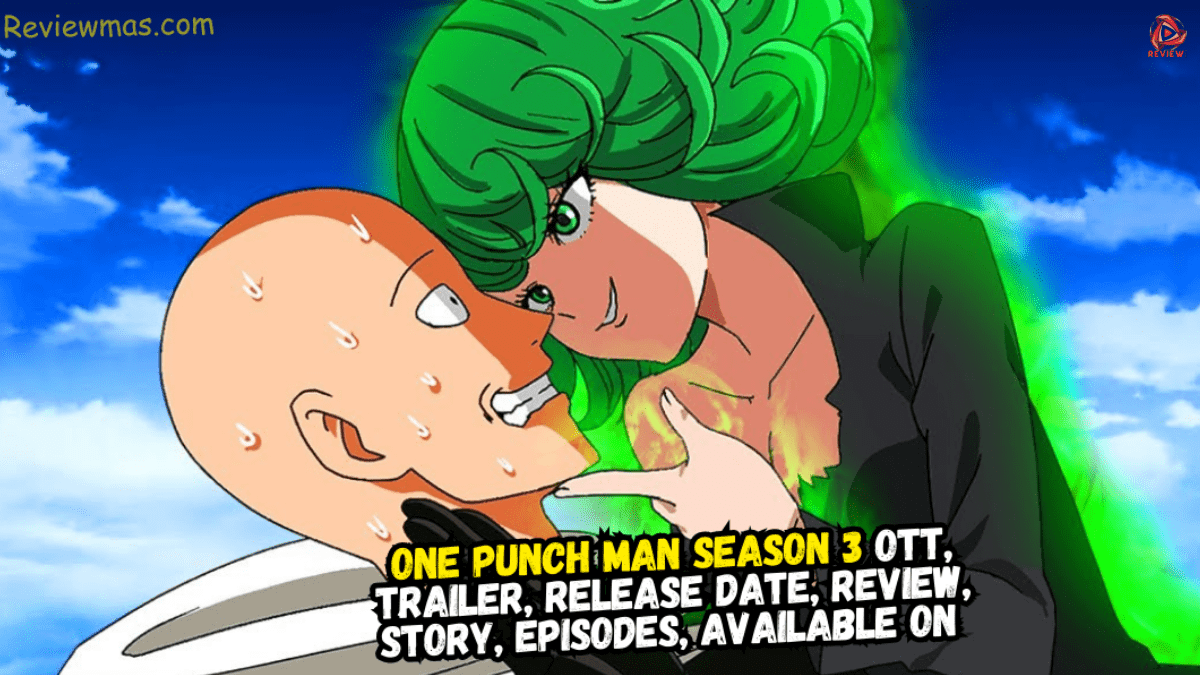Spirited Away Best Anime
Release Date: July 20, 2001
Review:
“Spirited Away,” directed by the renowned Hayao Miyazaki and produced by Studio Ghibli, stands as a timeless masterpiece in the world of anime movies. Released on July 20, 2001, the best anime film has garnered widespread acclaim for its enchanting narrative, breathtaking animation, and profound themes.

The story follows the adventures of Chihiro, a young girl who becomes trapped in a mysterious and magical world while on her way to her new home. The narrative unfolds with a perfect blend of fantasy and coming-of-age elements, capturing the audience’s attention from the very beginning. The world Miyazaki creates is both mesmerizing and surreal, filled with imaginative creatures, magical landscapes, and hidden meanings.
The characters in “Spirited Away” are intricately designed, each with their own unique personalities and quirks. Chihiro undergoes significant growth throughout the film, evolving from a timid and fearful girl to a courageous and determined protagonist. The supporting cast, including the enigmatic No-Face, the wise Yubaba, and the mysterious Haku, adds depth to the story and contributes to its emotional resonance.
Thematically, “Spirited Away” delves into the concepts of identity, courage, and the importance of empathy. Chihiro’s journey is not just a physical one but also a metaphorical exploration of self-discovery. The film encourages viewers to confront their fears, challenge societal expectations, and embrace their true selves. The environmental and anti-capitalist undertones further enrich the narrative, making “Spirited Away” a film with layers of meaning for audiences of all ages.
In terms of critical reception, “Spirited Away” has received universal acclaim. It won the Academy Award for Best Animated Feature in 2003, making it the first (and only, as of my knowledge cutoff in 2022) non-English language film to win in this category. The film’s success extends beyond awards, as it continues to resonate with audiences worldwide, earning a lasting place in the hearts of anime enthusiasts and film connoisseurs alike.
Your Name (Kimi no Na wa)
Release Date: August 26, 2016
Review:
“Your Name,” directed by Makoto Shinkai, took the anime world by storm upon its release on August 26, 2016. This visually stunning and emotionally resonant film has become a modern classic, captivating audiences with its unique blend of romance, fantasy, and time-travel elements.
The story revolves around Taki and Mitsuha, two teenagers who mysteriously swap bodies intermittently. As they navigate each other’s lives and form a connection that transcends time and space, the film explores themes of love, fate, and the profound impact of human connections. Shinkai weaves a narrative that is both intricate and heartfelt, keeping viewers on the edge of their seats until the final frame.
“Your Name” is celebrated for its breathtaking animation, characterized by detailed landscapes, vivid colors, and expressive character designs. The film’s visuals are not only aesthetically pleasing but also integral to the storytelling best anime . The contrast between Taki’s urban life in Tokyo and Mitsuha’s rural existence in Itomori is beautifully captured, emphasizing the duality of their experiences. The celestial events and natural phenomena depicted in the film add a touch of magic to the narrative, enhancing its otherworldly charm.
The characters of Taki and Mitsuha are portrayed with depth and authenticity. Their personal struggles, desires, and the evolution of their relationship are portrayed with sensitivity and nuance. The emotional resonance of “Your Name” is heightened by the relatability of its characters, making their journey a universal and poignant exploration of love and destiny.
The film’s soundtrack, composed by Radwimps, complements the narrative perfectly. The music enhances the emotional beats of the story, creating a powerful synergy between visuals and sound. The use of the song “Kataware Doki” during a pivotal scene has become iconic and is often associated with the film’s emotional impact.
“Your Name” received widespread acclaim from both critics and audiences. Its success extended beyond Japan, becoming a global phenomenon and earning accolades for its storytelling, animation, and emotional depth. The film’s box office success further solidified its status as a groundbreaking anime film, surpassing expectations and leaving an indelible mark on the medium.
Click Here To Watch For More Anime Movies
Akira
Release Date: July 16, 1988
Review:
“Akira,” directed by Katsuhiro Otomo and based on his own manga of the same name, is a groundbreaking anime film that has left an enduring impact on the medium since its release on July 16, 1988. Known for its dystopian setting, cyberpunk aesthetic, and visceral storytelling, “Akira” is a cinematic experience that pushed the boundaries of animation and paved the way for a new era of anime.
Set in a post-apocalyptic Tokyo known as Neo-Tokyo, the film follows Kaneda, a member of a motorcycle gang, as he becomes entangled in a government conspiracy involving psychic powers. The narrative is dense and complex, exploring themes of power, identity, and the consequences of unchecked scientific experimentation. “Akira” is a visual and auditory spectacle that engages the audience from start to finish.
The world of “Akira” is a character in itself, with its towering skyscrapers, neon-lit streets, and an atmosphere of decay and chaos. The film’s portrayal of a dystopian future was influential in shaping the cyberpunk genre not only in anime but also in global science fiction. The cityscape of Neo-Tokyo has become an iconic representation of a dark and technologically advanced future.
In terms of characters, “Akira” introduces a memorable and diverse cast, each contributing to the film’s exploration of its thematic elements. Kaneda’s journey from a brash and carefree youth to someone confronting the consequences of power is a central arc that adds emotional depth to the film. The mysterious and powerful Tetsuo undergoes a transformation that is both awe-inspiring and terrifying, symbolizing the destructive potential of unrestrained abilities.
Thematically, “Akira” delves into societal issues, political corruption, and the ethical implications of scientific experimentation. The film’s commentary on power and its consequences is as relevant today as it was at the time of its release. “Akira” serves as a thought-provoking exploration of humanity’s capacity for both creation and destruction.
Critical reception for “Akira” has been overwhelmingly positive, and its influence on anime and popular culture is immeasurable. It is often cited as a gateway anime for those new to the medium and is considered a must-watch for enthusiasts seeking to understand the evolution of anime as an art form. “Akira” remains a cinematic landmark, standing the test of time and continuing to inspire generations of filmmakers and artists.
Perfect Blue
Release Date: February 28, 1998
Review:
“Perfect Blue,” directed by Satoshi Kon and released on February 28, 1998, is a psychological thriller that delves into the blurred lines between reality and illusion. The film explores themes of identity, fame, and the psychological toll of the entertainment industry. “Perfect Blue” is a departure from traditional anime storytelling, presenting a mature and thought-provoking narrative.
Mima Kirigoe is a compelling protagonist whose internal struggles serve as the focal point of the narrative. As she grapples with the challenges of her new career and the haunting specter of her past as a pop idol, the audience is taken on a journey through the labyrinth of her mind. The film’s portrayal of Mima’s descent into madness is both haunting and empathetic, offering a nuanced exploration of the price of fame and the sacrifices individuals make for their dreams.
Thematically, “Perfect Blue” tackles issues such as the commodification of identity and the impact of obsessive fandom. The film’s critique of the entertainment industry’s exploitation of young talent and the toll it takes on mental health remains relevant, resonating with audiences who recognize the dark side of fame.
“Perfect Blue” received critical acclaim for its innovative storytelling and psychological depth. While initially not a commercial success, the film has gained a cult following over the years, and its influence on the anime industry and psychological thriller genre is undeniable. It paved the way for more mature and introspective anime narratives, challenging the perception of best anime animation as a strictly family-friendly medium.
In conclusion, “Spirited Away,” “Your Name,” “Akira,” and “Perfect Blue” stand as exemplary works in the anime film landscape, each contributing to the medium’s diversity and artistic evolution. From the enchanting worlds crafted by Miyazaki and Shinkai to the groundbreaking animation of “Akira” and the psychological complexity of “Perfect Blue,” these films showcase the depth and versatility of anime as a cinematic art form. Whether exploring themes of identity, love, power, or the darker aspects of fame, these best anime movies have left an indelible mark on audiences worldwide, solidifying their places as timeless classics in the realm of anime.
Grave of the Fireflies
Release Date: April 16, 1988
Review:
“Grave of the Fireflies,” directed by Isao Takahata and released on April 16, 1988, is a profoundly moving and heartbreaking anime film that explores the human cost of war. Produced by Studio Ghibli, the film diverges from the fantasy elements often associated with the studio, delivering a poignant and realistic portrayal of the impact of World War II on civilians.
The story revolves around two siblings, Seita and Setsuko, who struggle to survive in war-torn Japan after their hometown is bombed. The film unfolds as a retrospective narrative, with an elder Seita reflecting on the events that led to the tragic fate of himself and his younger sister. “Grave of the Fireflies” stands as a powerful anti-war statement, emphasizing the devastating consequences of conflict on innocent lives.
The animation in “Grave of the Fireflies” is both subtle and evocative. The film’s visual style, while not as fantastical as other Studio Ghibli productions, is nevertheless rich in detail and emotion. The subdued color palette and realistic character designs contribute to the film’s somber atmosphere, creating a stark contrast to the vivid and magical worlds often associated with the studio. The animation effectively captures the emotional weight of the narrative, conveying the hardships faced by the siblings with authenticity.
Thematically, “Grave of the Fireflies” explores the human cost of conflict and the impact of societal structures on individual lives. The film prompts reflection on the consequences of war beyond the battlefield, highlighting the resilience of the human spirit even in the face of unimaginable suffering. “Grave of the Fireflies” is a meditation on loss, sacrifice, and the enduring bond between siblings in the midst of adversity.
In summary, “Grave of the Fireflies” stands as a testament to the ability of anime to tackle complex and challenging themes. Its emotional impact, coupled with its realistic portrayal of the human experience during wartime, cements its status as a cinematic masterpiece that resonates with audiences on a profound level. The film’s enduring relevance is a testament to the timeless power of storytelling through animation.



